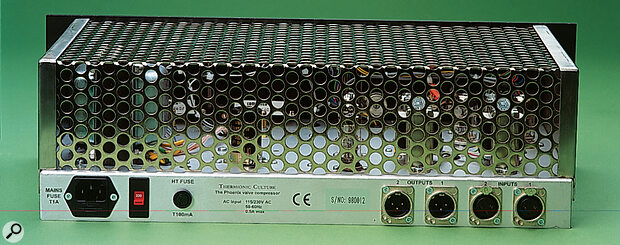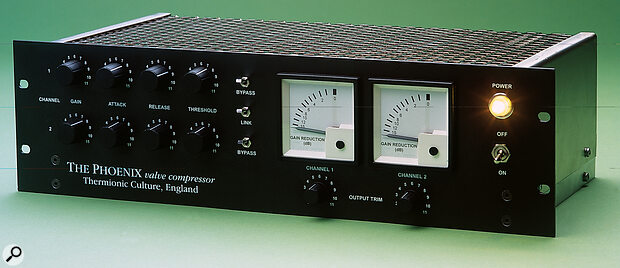The Phoenix all-valve compressor is a high flyer when it comes to quality and price. Will it help Thermionic Culture feather their nest?
For a couple of grand, you can buy a Pentium III audio workstation computer, complete with audio/sequencing software, acres of hard-drive space, CD-burning capability, VST plug-ins to handle all your virtual processing needs, and more audio track-recording capability than you can shake a stick at. Or you can blow it all on a Phoenix two-channel tube compressor!
This comparison just serves to remind us that there's still a world of difference between the best audio hardware, as used in pro studios, and what you can expect from a budget PC-based desktop studio. Working in accordance with the 'weakest link in the chain' theory, it would only make sense to consider buying something like the Phoenix if the rest of your audio system had a high-quality signal path, but anyone with 20-bit ADATs, pro-format open-reel analogue tape, or a high-class tapeless system should be able to benefit from what it offers.
Features & Construction
The Phoenix is a stereo compressor that may also be used in dual-mono mode. It has a soft-knee characteristic (where the compression ratio automatically increases the further the input signal exceeds the threshold) and, most importantly, an all-valve signal path. Hand-built in an ADAT-sized rack case, the Phoenix uses a standard chassis style of construction to hold its valves and transformers. All the wiring is done by hand to a competent standard, though I have seen tidier jobs. The stainless-steel lid has large perforations that give it a kind of 'balti-warmer' look and should provide more than enough ventilation to prevent the Phoenix following in the footsteps (clawsteps?) of its mythical namesake. Six valves are visible through the cover, alongside two chunky Sowter transformers. There's no information about the valve line-up in the manual, other than the fact that matched replacements are available through Thermionic Culture. I didn't recognise any of the valve types, though some appeared to have MOD part numbers.
In keeping with its esoteric design philosophy, the Phoenix has a frequency response flat within a dB from 10Hz to 35kHz, while its 15k(omega) input impedance shouldn't provide too much of a challenge to the equipment feeding it. The audio connections are via balanced XLRs on the rear panel — no concessions to the namby-pamby jack-wielding semi-pros here!
 Phoenix rear panel connections.
Phoenix rear panel connections.
Control-wise, the unit is pretty straightforward, with large knobs for Gain, Attack, Release and Threshold. Each channel has a bypass toggle switch, and a further switch links the two side-chains for stereo operation. There's no external side-chain access and, of course, this particular style of soft-knee compressor doesn't require a ratio control. Separate Output Trim controls are provided for the two channels, and gain reduction is monitored via two huge moving-coil meters. The green power lamp is so large and retro looking that it wouldn't be out of place on the side of a Dalek's head! There are no status LEDs for bypass or stereo linking — presumably the designer's aversion to solid-state devices extends to light-emitting diodes?
Control Functions
The amount of compression is controlled by both the input Gain control and the Threshold control. As pointed out earlier, the ratio increases progressively, up to a maximum of around 20:1 at 20dBs of gain reduction. Attack covers the range 5mS to 250mS, while Release can be adjusted from 120mS to 2.2S.
It's conventional for a stereo link switch to be used to allow the two compressors to track properly when processing stereo signals, but the Phoenix's manual also suggests a dodge for creating frequency-conscious compression using this switch. Essentially, one channel is used as the signal path while the second is fed an equalised signal. Channel one's compression is minimised by setting the threshold to maximum, so that both channels track according to the equalised signal being fed to channel two. Adding HF boost to the channel two feed will cause the compressor to respond more to high frequencies, so you can use this to de-ess. This method is perfectly valid, but of course it ties up both compressor channels to process one signal. Side-chain insert points, if provided, would allow both channels to be used for frequency-conscious applications at the same time, if required.
Also pointed out in the manual is the fact that moving-coil meters aren't fast enough to respond to all the signal peaks, so their indications can only be approximate. More often than not, moving-coil meters correspond more accurately with what your ear perceives than peak-reading meters, but they don't tell you the true signal level.
While modern 24-bit digital systems boast signal-to-noise ratios in excess of 100dB, valve circuitry needs to be very well designed to better 80dB. This particular unit manages a noise figure of 85dB below the maximum output level, while the distortion figure is less than 0.1% with no compression applied. The latter figure will inevitably increase alongside the amount of gain reduction, but that's part of the valve compressor sound and the resulting warm, musical distortion is one reason why people are prepared to pay premium prices for valve units.
In Use
Thanks to the simple control system, setting up the Phoenix is pretty easy, though I found that release times towards the faster end of the scale were usually most effective. You can hear the compressor working pretty much as soon as the gain-reduction meter starts to twitch.
As you might imagine, the compression characteristic is designed to be flattering and musical, with more than a hint of warmth. The result is a smooth, big and very immediate sound that works well with vocals and most pop instruments, including bass guitar. There's definitely a tonal richness that you don't get with most solid-state compressors, but at the same time the high end keeps its integrity, even when quite a lot of gain reduction is being used — providing the attack time isn't set to too fast a value.
The output gain trim doesn't offer complete attenuation, so there are occasions when the compressor adds gain to the input signal to such a degree that you can't do an 'equal level' comparison by flipping the bypass switch. This can make setting up awkward when you're dealing with low-level input signals, but those with digital equipment will be pleased to hear that the +20dBu maximum output level is high enough to drive anything short of a fan heater!
Feathered Friend?
The Phoenix is a very sweet-sounding compressor, with a warm, vintage character, that actively flatters rather than simply controlling gain. There isn't a lot of variation in the character of compression that can be achieved — though you can create more or less 'pumping' by tweaking the attack/release settings — but I don't think there are many people who'd be unhappy about the Phoenix's effect on their vocal tracks.
I feel the lack of a side-chain insert point is a bit of an omission on a unit of this price, as both channels need to be used for mono de-essing. If this were my compressor, though, I don't think I'd be asking it to function as a run-of-the-mill de-esser very often! Realistically, this is a lot of money to spend on what is effectively a 'one-trick' compressor, especially when you consider how much kit you could otherwise buy for the same money, but, as I said at the outset, that's the price you pay for having gear at the pointy end of the quality/price pyramid.
The whole philosophy of a compressor like this revolves around its subjective sound quality rather than its technical specification, so I feel it would be unwise to buy one without comparing it with the other high-end models out there. However, having tried a few other high-end tube compressors, I think it fair to say that this one compares favourably, while retaining a character of its own.
Pros
- Simple user interface.
- Smooth, musical sound
- Plenty of output level.
Cons
- No side-chain insert point.
- Only one basic tonal character.
Summary
You have to be serious to look at a compressor in this price bracket, but if you're after high‑quality results and you want something a little bit special to flatter your vocal and instrumental sounds, the Phoenix will do the job nicely.

